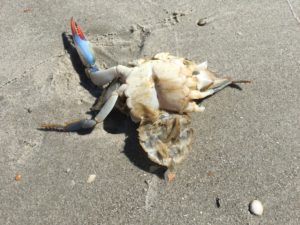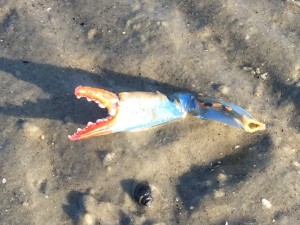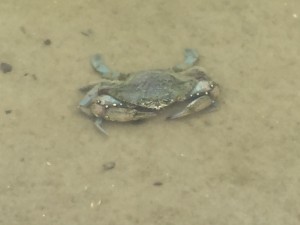The largest (and tastiest) crab on HHI, the Blue Crab lives in the brackish water of the salt marsh as well as the salty ocean. These swimming crabs derive their name from the bright blue claws of the male, with the females claws tipped in orange or red (like nail polish!), It is the female crab most commonly found on the beach as she makes her way from the marsh inlets to the ocean to spawn, the males spending their lives in the protected waters of estuaries and marshes.
The more accurate, albeit more dangerous, way to tell the gender of a blue crab is to look at the abdomen. The blue crab has what is called a “reduced abdomen”, what we call the “apron,” folded against the belly. One way to think about this is to make a crab out of a lobster by folding the tail up under its body between the legs, then press the tail up into its bottom shell until it’s flush. Voilà! You now have a crab… well, sort of! A male blue crab has a long, narrow apron, which I refer to in talks as the “Washington Monument.” The female has an apron shaped like a triangle” (juvenile) or inverted “U” (adult). The adults can open their aprons to mate, and the female will carry her eggs tucked between the apron and her abdomen.
If you would care to read a bit more, visit my post from May 9, 2016.
- The apron of this female has lifted away from the body.
- It is between the apron and her abdomen that the female carries her eggs, the egg mass being called a “sponge”.
- Pulling one of the crab pots from the floating dock on the salt marsh at the Coastal Discovery Museum.
- Watch those claws! Trapped at the floating dock at the Coastal Discovery Museum.
- Even just the claw is a bit intimidating. True crabs have 5 pairs of legs, the first pair with pinchers, and the next 3 pairs used for walking.
- Swimming crabs, such as the Blue crab, Have the ends of their last pair of legs modified into wide, flat paddles.
- A Blue Crab buried in the silt of a salt water lagoon.
- Body pits where crabs once were.
Crab hatchlings begin life in the ocean as zooplankton, undergoing seven or eight changes in body shape before reaching their adult shape (while still only the size of a pinhead!). The tiny crabs ride the ocean currents into the protected waters of the estuaries and marshes, growing rapidly to one or two inches in size before burrowing in the mud for their first winter. The crab will molt 20 or more times before reaching full adult size.
The Blue Crab displays an amazing adaptability. It can survive in the high salinity of ocean water, as well as fresh. If it loses a leg it can grow a new one at its next molt. It can swim fast, crawl rapidly, and burrow into the mud quickly for protection. And although eaten by many, the Blue Crab is a fierce predator in its own right, eating eating fish, shrimp, and other crabs. The Blue Crab even shows its “smarts” by grabinbg and shaking the Spartina grass to dislodge the Periwinkle Snails from their hiding spots.












